异常接管主文件 更多...
函数 | |
| VOID | OsExcHook (UINT32 excType, ExcContext *excBufAddr, UINT32 far, UINT32 fsr) |
| 由注册后回调,发送异常情况下会回调这里执行,见于 OsUndefIncExcHandleEntry, OsExcHandleEntry ==函数 更多... | |
| STATIC | SPIN_LOCK_INIT (g_excSerializerSpin) |
| UINT32 | OsGetSystemStatus (VOID) |
| 获取系统状态 更多... | |
| STATIC INT32 | OsDecodeFS (UINT32 bitsFS) |
| STATIC INT32 | OsDecodeInstructionFSR (UINT32 regIFSR) |
| STATIC INT32 | OsDecodeDataFSR (UINT32 regDFSR) |
| UINT32 | OsArmSharedPageFault (UINT32 excType, ExcContext *frame, UINT32 far, UINT32 fsr) |
| 共享页缺失异常 更多... | |
| STATIC VOID | OsExcType (UINT32 excType, ExcContext *excBufAddr, UINT32 far, UINT32 fsr) |
| 异常类型 更多... | |
| STATIC VADDR_T | OsGetTextRegionBase (LosVmMapRegion *region, LosProcessCB *runProcess) |
| STATIC VOID | OsExcSysInfo (UINT32 excType, const ExcContext *excBufAddr) |
| 打印异常系统信息 更多... | |
| STATIC VOID | OsExcRegsInfo (const ExcContext *excBufAddr) |
| 异常情况下打印各寄存器的信息 更多... | |
| LITE_OS_SEC_TEXT_INIT UINT32 | LOS_ExcRegHook (EXC_PROC_FUNC excHook) |
| 注册异常处理钩子 更多... | |
| EXC_PROC_FUNC | OsExcRegHookGet (VOID) |
| 获取hook函数 更多... | |
| STATIC VOID | OsDumpExcVaddrRegion (LosVmSpace *space, LosVmMapRegion *region) |
| dump 虚拟空间下异常虚拟地址线性区 更多... | |
| STATIC VOID | OsDumpProcessUsedMemRegion (LosProcessCB *runProcess, LosVmSpace *runspace, UINT16 vmmFlags) |
| dump 进程使用的内存线性区 更多... | |
| STATIC VOID | OsDumpProcessUsedMemNode (UINT16 vmmFlags) |
| dump 进程使用的内存节点 更多... | |
| VOID | OsDumpContextMem (const ExcContext *excBufAddr) |
| dump 上下文内存,注意内核异常不能简单的映射理解为应用的异常,异常对内核来说是一个很常见操作, 比如任务的切换对内核来说就是一个异常处理 更多... | |
| STATIC VOID | OsExcRestore (VOID) |
| 异常恢复,继续执行 更多... | |
| STATIC VOID | OsUserExcHandle (ExcContext *excBufAddr) |
| 用户态异常处理函数 更多... | |
| STATIC INLINE BOOL | IsValidFP (UINTPTR regFP, UINTPTR start, UINTPTR end, vaddr_t *vaddr) |
| 此函数用于验证fp或验证检查开始和结束范围 更多... | |
| STATIC INLINE BOOL | FindSuitableStack (UINTPTR regFP, UINTPTR *start, UINTPTR *end, vaddr_t *vaddr) |
| 找到一个合适的栈 更多... | |
| BOOL | OsGetUsrIpInfo (UINTPTR ip, IpInfo *info) |
| UINT32 | BackTraceGet (UINTPTR regFP, IpInfo *callChain, UINT32 maxDepth) |
| VOID | BackTraceSub (UINTPTR regFP) |
| VOID | BackTrace (UINT32 regFP) |
| 打印调用栈信息 更多... | |
| VOID | OsExcInit (VOID) |
| 异常接管模块的初始化 更多... | |
| VOID | OsCallStackInfo (VOID) |
| 打印调用栈信息 更多... | |
| VOID | OsTaskBackTrace (UINT32 taskID) |
| Kernel task backtrace function. 更多... | |
| VOID | OsBackTrace (VOID) |
| Kernel backtrace function. 更多... | |
| VOID | OsUndefIncExcHandleEntry (ExcContext *excBufAddr) |
| 未定义的异常处理函数,由汇编调用 见于 los_hw_exc.s 更多... | |
| VOID | OsPrefetchAbortExcHandleEntry (ExcContext *excBufAddr) |
| 预取指令异常处理函数,由汇编调用 见于 los_hw_exc.s 更多... | |
| VOID | OsDataAbortExcHandleEntry (ExcContext *excBufAddr) |
| 数据中止异常处理函数,由汇编调用 见于 los_hw_exc.s 更多... | |
| STATIC VOID | WaitAllCpuStop (UINT32 cpuid) |
| 等待所有CPU停止 更多... | |
| STATIC VOID | OsWaitOtherCoresHandleExcEnd (UINT32 currCpuid) |
| STATIC VOID | OsCheckAllCpuStatus (VOID) |
| 检查所有CPU的状态 更多... | |
| STATIC VOID | OsCheckCpuStatus (VOID) |
| LITE_OS_SEC_TEXT VOID STATIC | OsExcPriorDisposal (ExcContext *excBufAddr) |
| 执行期间的优先处理 excBufAddr为CPU异常上下文, 更多... | |
| LITE_OS_SEC_TEXT_INIT STATIC VOID | OsPrintExcHead (UINT32 far) |
| 异常信息头部打印 更多... | |
| STATIC VOID | OsSysStateSave (UINT32 *intCount, UINT32 *lockCount) |
| STATIC VOID | OsSysStateRestore (UINT32 intCount, UINT32 lockCount) |
| LITE_OS_SEC_TEXT_INIT VOID | OsExcHandleEntry (UINT32 excType, ExcContext *excBufAddr, UINT32 far, UINT32 fsr) |
| __attribute__ ((noinline)) | |
| 可变参数,输出到控制台 更多... | |
| VOID | __stack_chk_fail (VOID) |
| VOID | LOS_RecordLR (UINTPTR *LR, UINT32 LRSize, UINT32 recordCount, UINT32 jumpCount) |
| record LR function. 更多... | |
变量 | |
| STATIC UINTPTR | g_minAddr |
| STATIC UINTPTR | g_maxAddr |
| STATIC UINT32 | g_currHandleExcCpuid = INVALID_CPUID |
| UINT32 | g_curNestCount [LOSCFG_KERNEL_CORE_NUM] = {0} |
| 记录当前嵌套异常的数量 更多... | |
| BOOL | g_excFromUserMode [LOSCFG_KERNEL_CORE_NUM] |
| 记录CPU core 异常来自用户态还是内核态 TRUE为用户态,默认为内核态 更多... | |
| STATIC EXC_PROC_FUNC | g_excHook = (EXC_PROC_FUNC)OsExcHook |
| 全局异常处理钩子 更多... | |
| STATIC UINT32 | g_currHandleExcPID = OS_INVALID_VALUE |
| STATIC UINT32 | g_nextExcWaitCpu = INVALID_CPUID |
| STATIC const StackInfo | g_excStack [] |
| STATIC const CHAR * | g_excTypeString [] |
| USED UINT32 | __stack_chk_guard = 0xd00a0dff |
详细描述
异常接管主文件
基本概念
异常接管是操作系统对运行期间发生的异常情况(芯片硬件异常)进行处理的一系列动作,
例如打印异常发生时当前函数的调用栈信息、CPU现场信息、任务的堆栈情况等。
异常接管作为一种调测手段,可以在系统发生异常时给用户提供有用的异常信息,譬如异常类型、
发生异常时的系统状态等,方便用户定位分析问题。
异常接管,在系统发生异常时的处理动作为:显示异常发生时正在运行的任务信息
(包括任务名、任务号、堆栈大小等),以及CPU现场等信息。
运作机制
每个函数都有自己的栈空间,称为栈帧。调用函数时,会创建子函数的栈帧,
同时将函数入参、局部变量、寄存器入栈。栈帧从高地址向低地址生长。
以ARM32 CPU架构为例,每个栈帧中都会保存PC、LR、SP和FP寄存器的历史值。
ARM处理器中的R13被用作SP
堆栈分析
LR寄存器(Link Register),链接寄存器,指向函数的返回地址。
R11:可以用作通用寄存器,在开启特定编译选项时可以用作帧指针寄存器FP,用来实现栈回溯功能。
GNU编译器(gcc)默认将R11作为存储变量的通用寄存器,因而默认情况下无法使用FP的栈回溯功能。
为支持调用栈解析功能,需要在编译参数中添加-fno-omit-frame-pointer选项,提示编译器将R11作为FP使用。
FP寄存器(Frame Point),帧指针寄存器,指向当前函数的父函数的栈帧起始地址。利用该寄存器可以得到父函数的栈帧,
从栈帧中获取父函数的FP,就可以得到祖父函数的栈帧,以此类推,可以追溯程序调用栈,得到函数间的调用关系。
当系统发生异常时,系统打印异常函数的栈帧中保存的寄存器内容,以及父函数、祖父函数的
栈帧中的LR、FP寄存器内容,用户就可以据此追溯函数间的调用关系,定位异常原因。
异常接管对系统运行期间发生的芯片硬件异常进行处理,不同芯片的异常类型存在差异,具体异常类型可以查看芯片手册。
异常接管一般的定位步骤如下:
打开编译后生成的镜像反汇编(asm)文件。
搜索PC指针(指向当前正在执行的指令)在asm中的位置,找到发生异常的函数。
根据LR值查找异常函数的父函数。
重复步骤3,得到函数间的调用关系,找到异常原因。
注意事项
要查看调用栈信息,必须添加编译选项宏-fno-omit-frame-pointer支持stack frame,否则编译时FP寄存器是关闭的。
参考
http://weharmonyos.com/openharmony/zh-cn/device-dev/kernel/%E7%94%A8%E6%88%B7%E6%80%81%E5%BC%82%E5%B8%B8%E4%BF%A1%E6%81%AF%E8%AF%B4%E6%98%8E.html- 版本
- 日期
- 2021-11-20
在文件 los_exc.c 中定义.
函数说明
◆ __attribute__()
| __attribute__ | ( | (noinline) | ) |
可变参数,输出到控制台
异常信息的输出
VOID OsVprintf(const CHAR *fmt, va_list ap, OutputType type)
printf由 print 和 format 两个单词构成,格式化输出函数, 一般用于向标准输出设备按规定格式输出信息
Definition: los_printf.c:138
函数调用图:
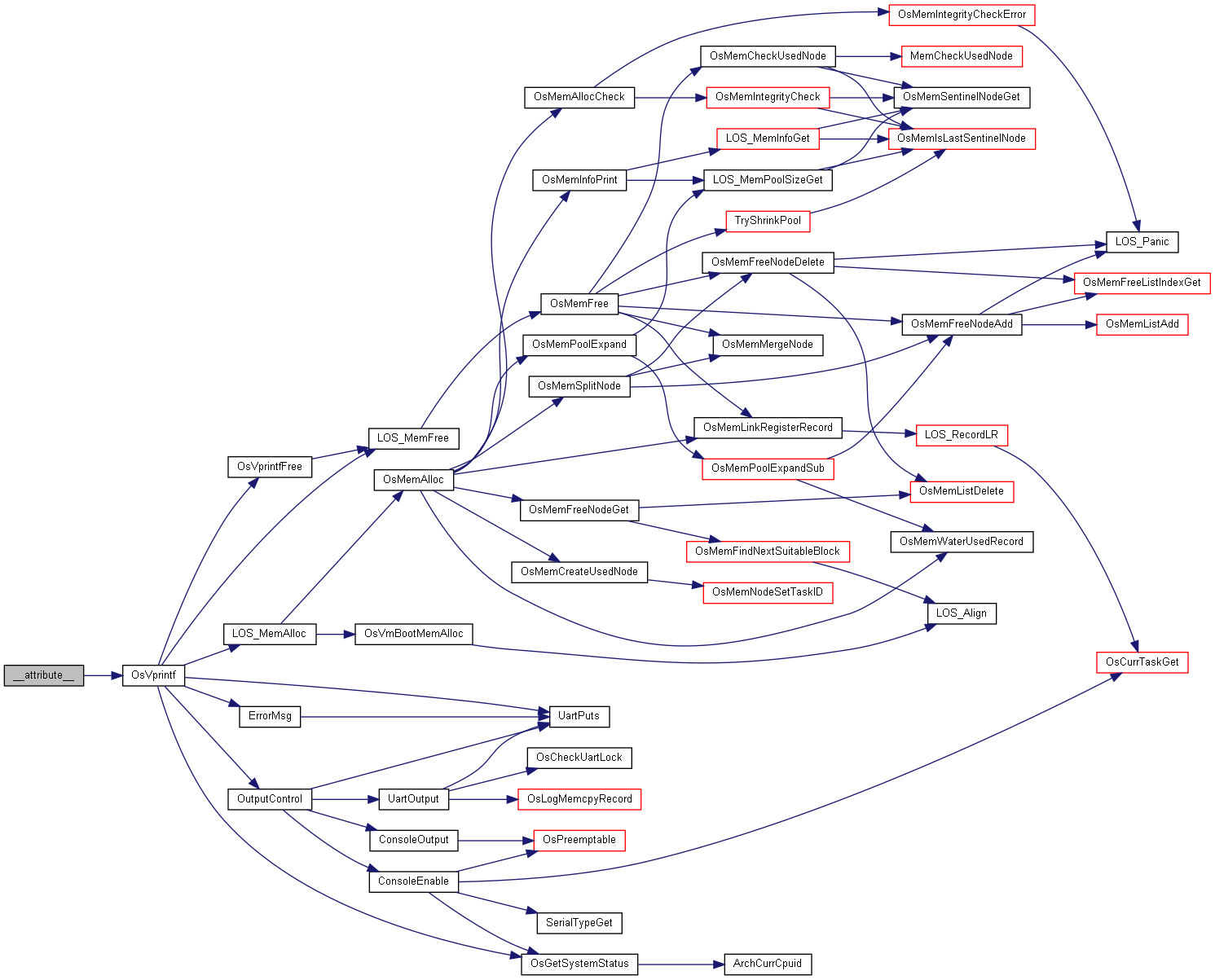
◆ __stack_chk_fail()
| VOID __stack_chk_fail | ( | VOID | ) |
函数调用图:

◆ BackTrace()
| VOID BackTrace | ( | UINT32 | regFP | ) |
打印调用栈信息
函数调用图:
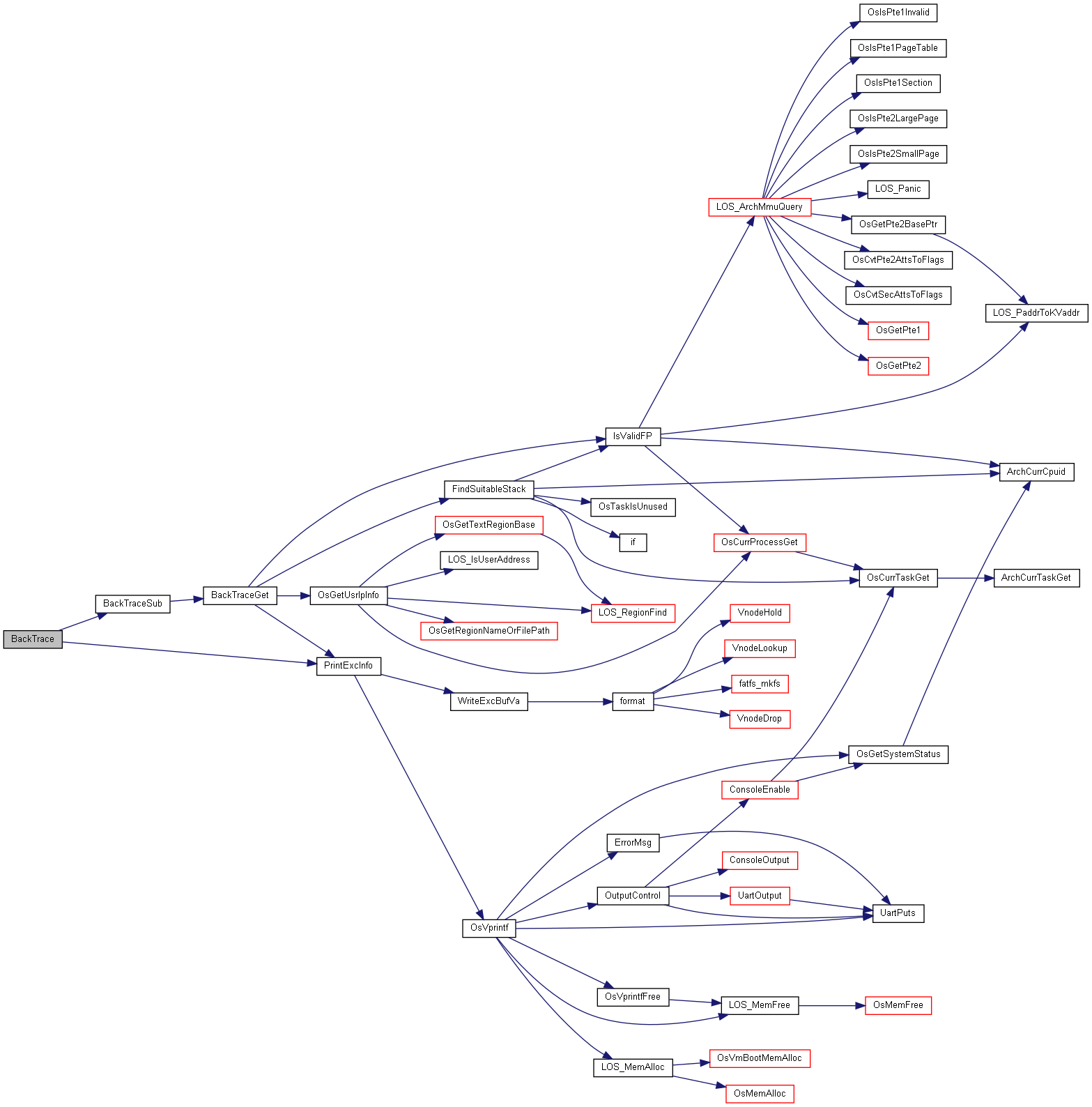
这是这个函数的调用关系图:
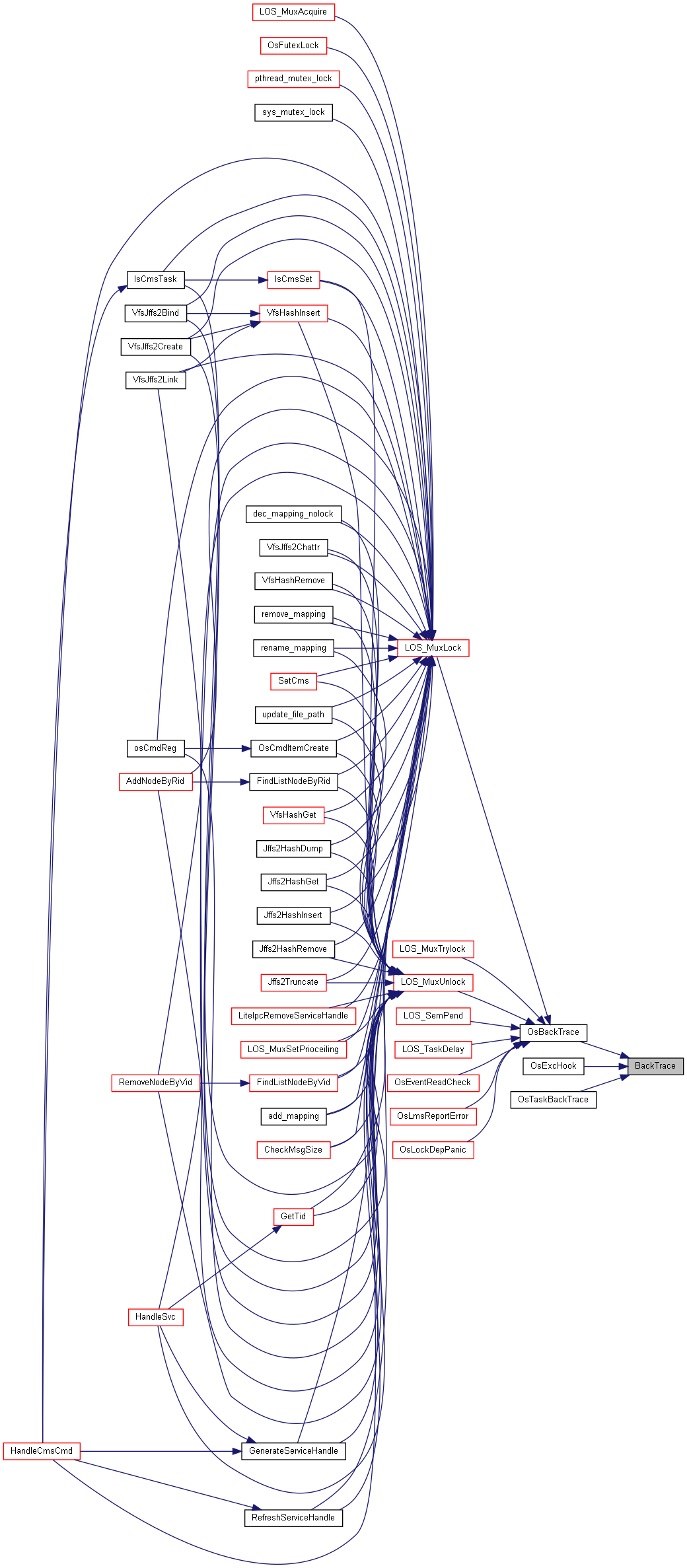
◆ BackTraceGet()
868 * Generally, the frame pointer points to the address of link register, while in the leaf function,
869 * there's no function call, and compiler will not store the link register, but the frame pointer
870 * will still be stored and updated. In that case we needs to find the right position of frame pointer.
STATIC INLINE BOOL IsValidFP(UINTPTR regFP, UINTPTR start, UINTPTR end, vaddr_t *vaddr)
此函数用于验证fp或验证检查开始和结束范围
Definition: los_exc.c:716
STATIC INLINE BOOL FindSuitableStack(UINTPTR regFP, UINTPTR *start, UINTPTR *end, vaddr_t *vaddr)
找到一个合适的栈
Definition: los_exc.c:747
Definition: los_exc_pri.h:49
函数调用图:

这是这个函数的调用关系图:
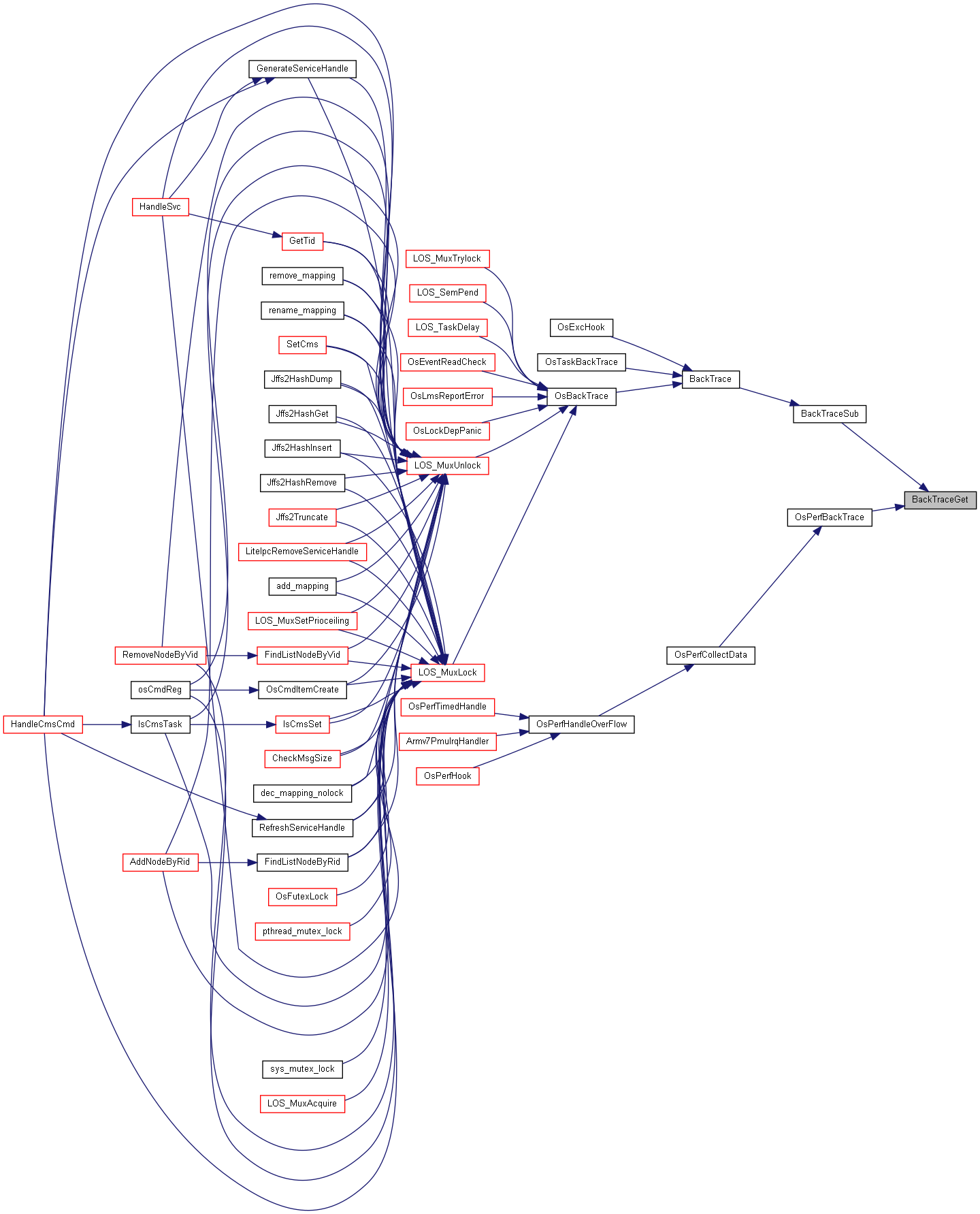
◆ BackTraceSub()
| VOID BackTraceSub | ( | UINTPTR | regFP | ) |
UINT32 BackTraceGet(UINTPTR regFP, IpInfo *callChain, UINT32 maxDepth)
Definition: los_exc.c:850
函数调用图:

这是这个函数的调用关系图:

◆ FindSuitableStack()
| STATIC INLINE BOOL FindSuitableStack | ( | UINTPTR | regFP, |
| UINTPTR * | start, | ||
| UINTPTR * | end, | ||
| vaddr_t * | vaddr | ||
| ) |
找到一个合适的栈
BOOL g_excFromUserMode[LOSCFG_KERNEL_CORE_NUM]
记录CPU core 异常来自用户态还是内核态 TRUE为用户态,默认为内核态
Definition: los_exc.c:129
Definition: los_stackinfo_pri.h:47
Definition: los_sched_pri.h:360
函数调用图:

这是这个函数的调用关系图:
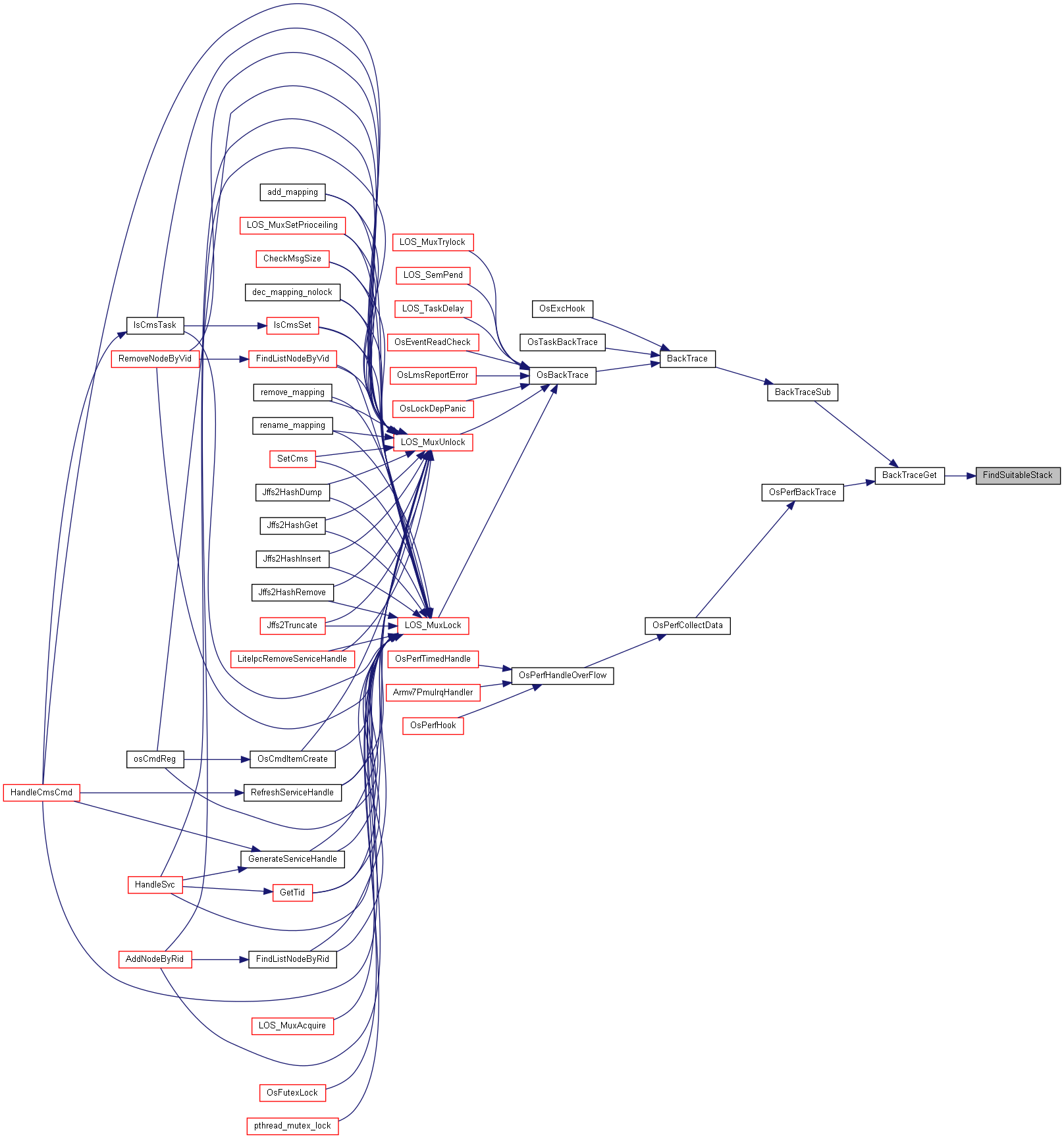
◆ IsValidFP()
此函数用于验证fp或验证检查开始和结束范围
STATUS_T LOS_ArchMmuQuery(const LosArchMmu *archMmu, VADDR_T vaddr, PADDR_T *paddr, UINT32 *flags)
LOS_ArchMmuQuery 获取进程空间虚拟地址对应的物理地址以及映射属性。 本函数是内核高频函数,通过MMU查询虚拟地址是否映射过,带走映射的物理地址和权限
Definition: los_arch_mmu.c:569
STATIC INLINE LosProcessCB * OsCurrProcessGet(VOID)
Definition: los_process_pri.h:353
Definition: los_process_pri.h:82
函数调用图:
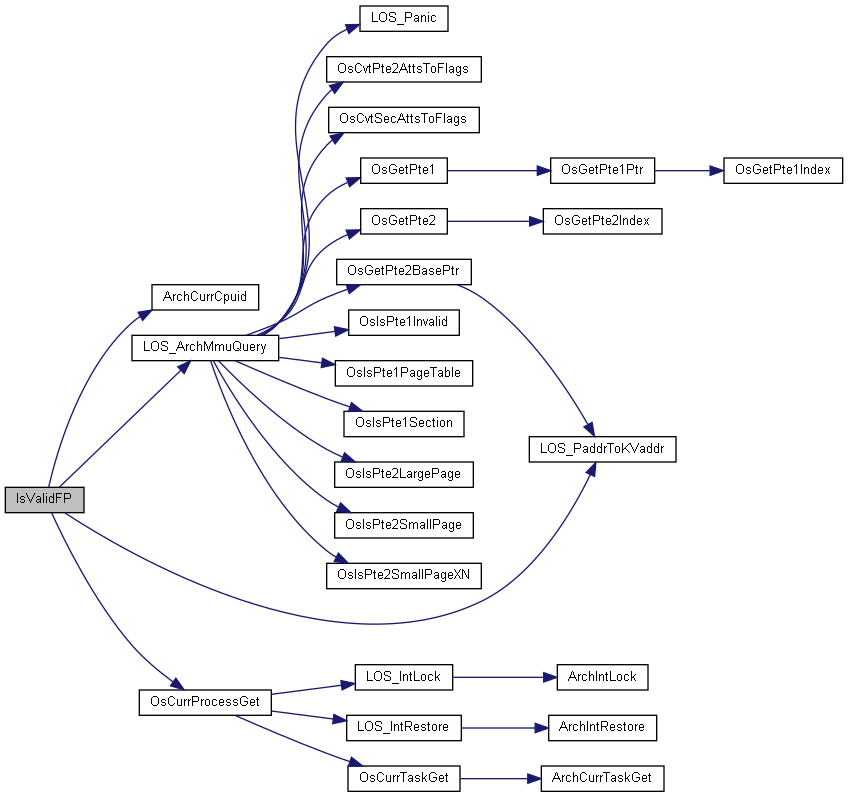
这是这个函数的调用关系图:
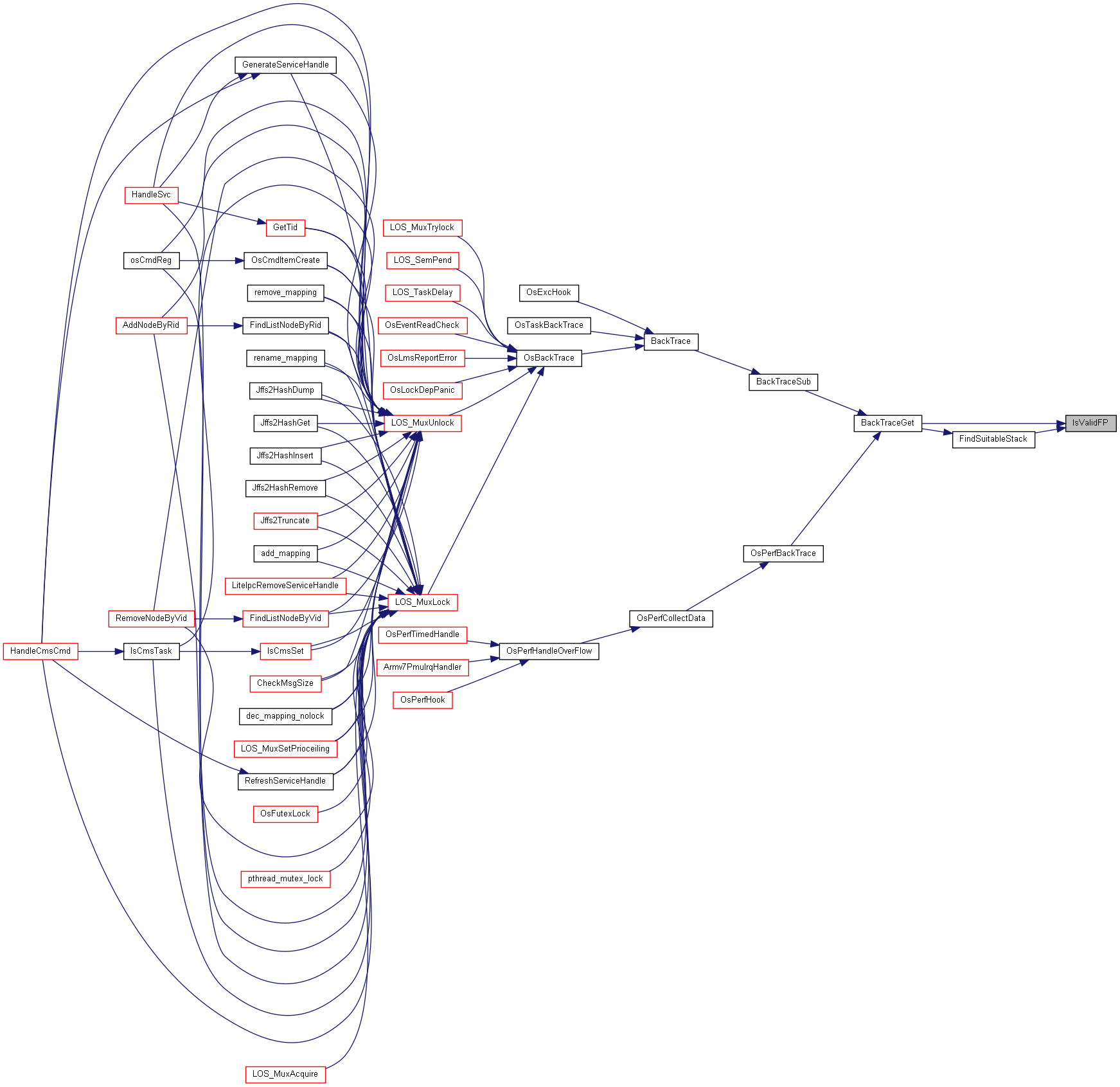
◆ OsArmSharedPageFault()
| UINT32 OsArmSharedPageFault | ( | UINT32 | excType, |
| ExcContext * | frame, | ||
| UINT32 | far, | ||
| UINT32 | fsr | ||
| ) |
共享页缺失异常
- 参数
-
excType frame far 异常状态寄存器(Fault Status Register -FAR) fsr 异常地址寄存器(Fault Address Register -FSR)
- 返回
- UINT32
290 fsrFlag = ((BIT_GET(fsr, FSR_FLAG_OFFSET_BIT) ? 0b10000 : 0) | BITS_GET(fsr, FSR_BITS_BEGIN_BIT, 0));
SPIN_LOCK_S g_taskSpin
STATUS_T OsVmPageFaultHandler(VADDR_T vaddr, UINT32 flags, ExcContext *frame)
Definition: los_vm_fault.c:352
函数调用图:

◆ OsCallStackInfo()
| VOID OsCallStackInfo | ( | VOID | ) |
打印调用栈信息
函数调用图:
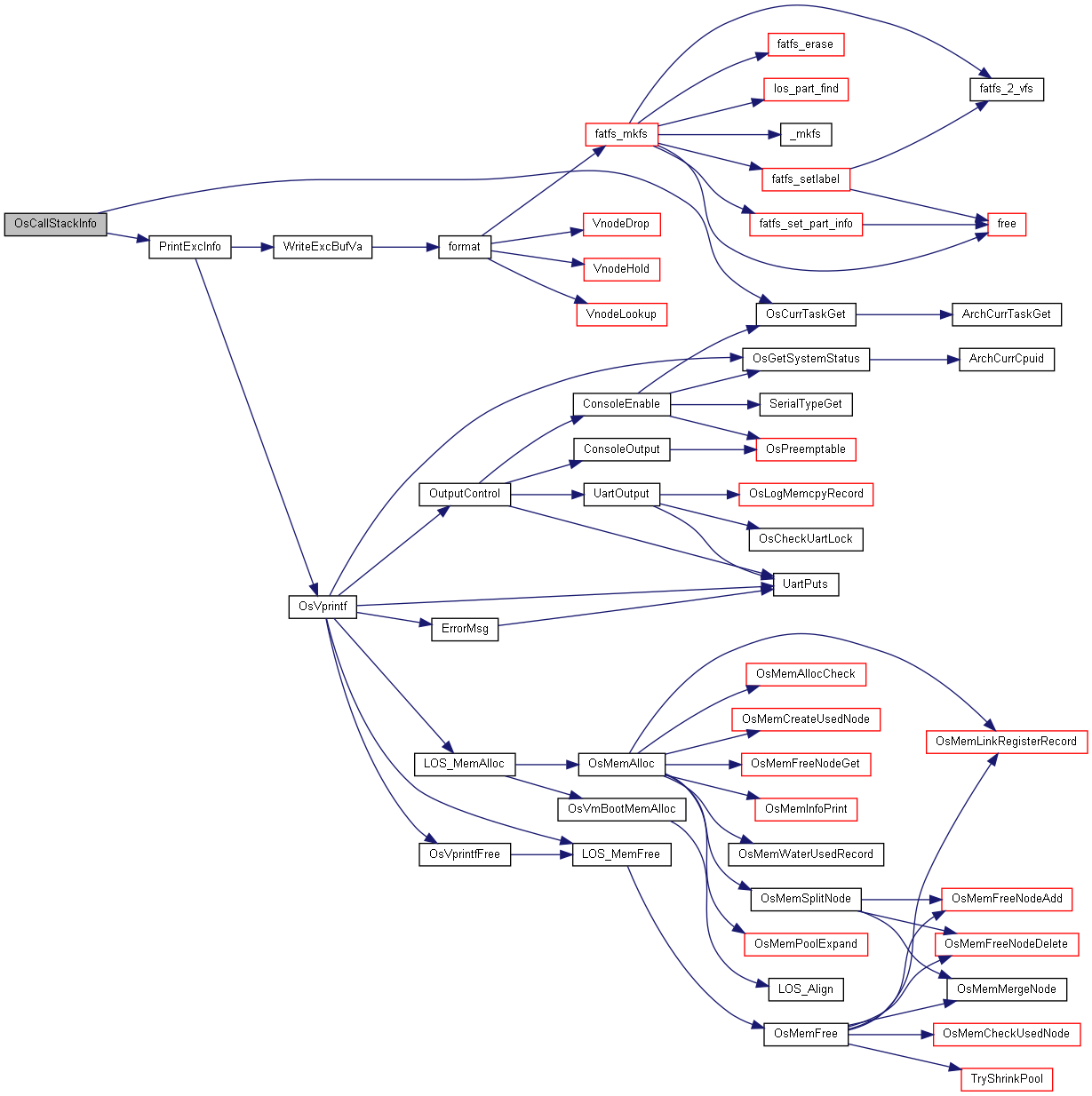
这是这个函数的调用关系图:

◆ OsCheckAllCpuStatus()
| STATIC VOID OsCheckAllCpuStatus | ( | VOID | ) |
检查所有CPU的状态
1173 if ((g_currHandleExcCpuid < LOSCFG_KERNEL_CORE_NUM) && (g_excFromUserMode[g_currHandleExcCpuid] == TRUE)) {
STATIC VOID OsWaitOtherCoresHandleExcEnd(UINT32 currCpuid)
Definition: los_exc.c:1120
函数调用图:
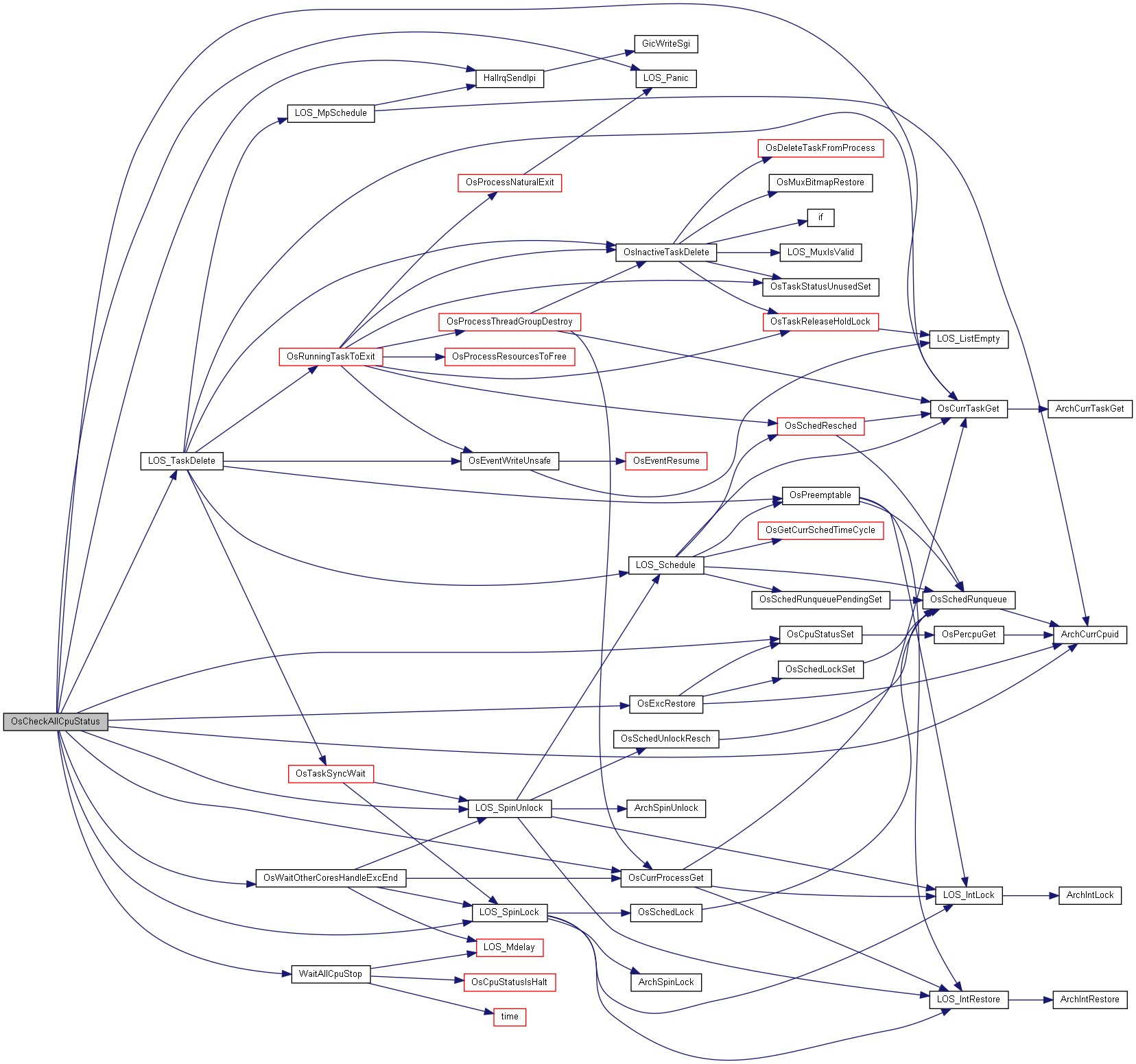
这是这个函数的调用关系图:

◆ OsCheckCpuStatus()
| STATIC VOID OsCheckCpuStatus | ( | VOID | ) |
函数调用图:
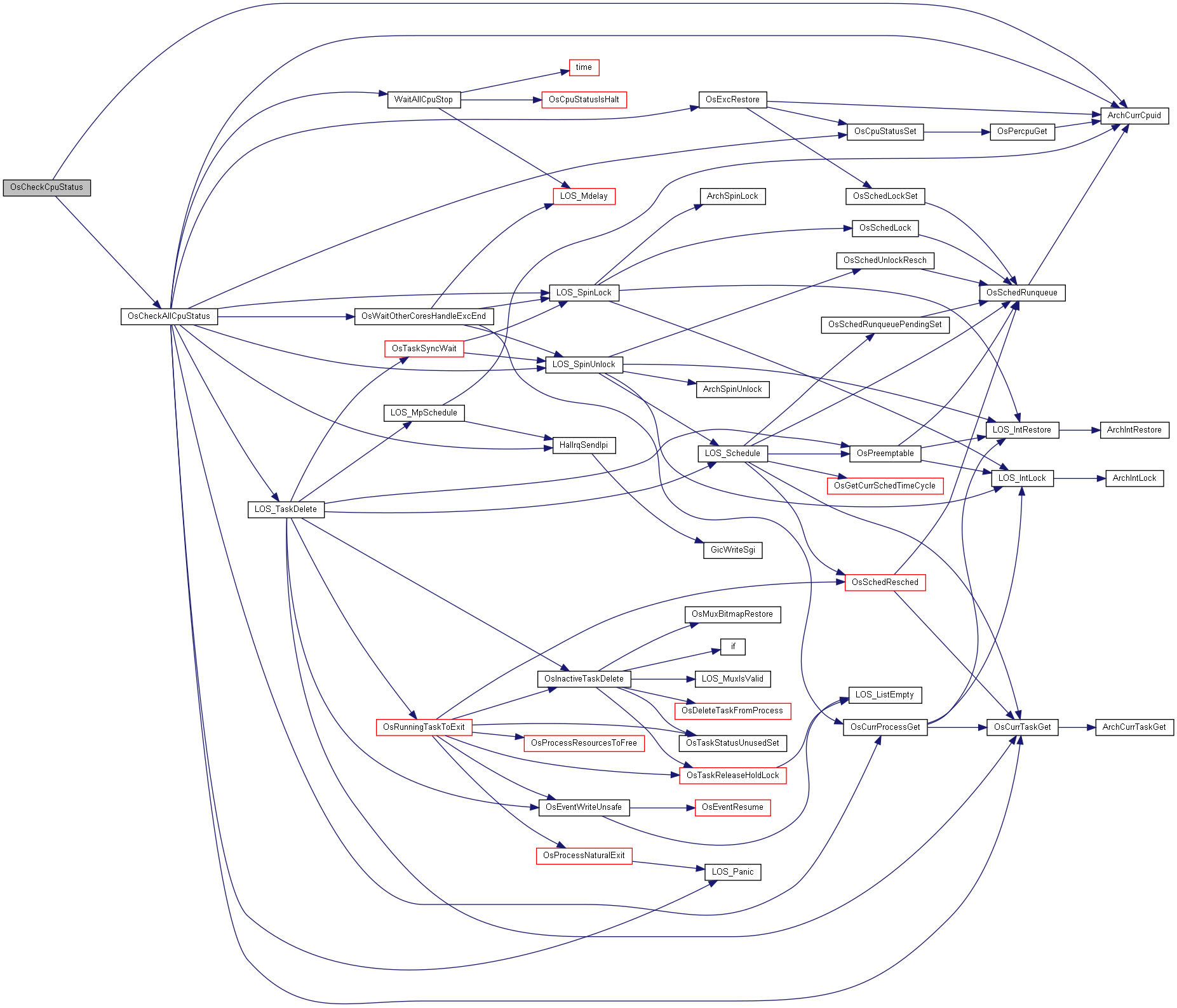
这是这个函数的调用关系图:

◆ OsDataAbortExcHandleEntry()
| VOID OsDataAbortExcHandleEntry | ( | ExcContext * | excBufAddr | ) |
数据中止异常处理函数,由汇编调用 见于 los_hw_exc.s
函数调用图:

◆ OsDecodeDataFSR()
函数调用图:
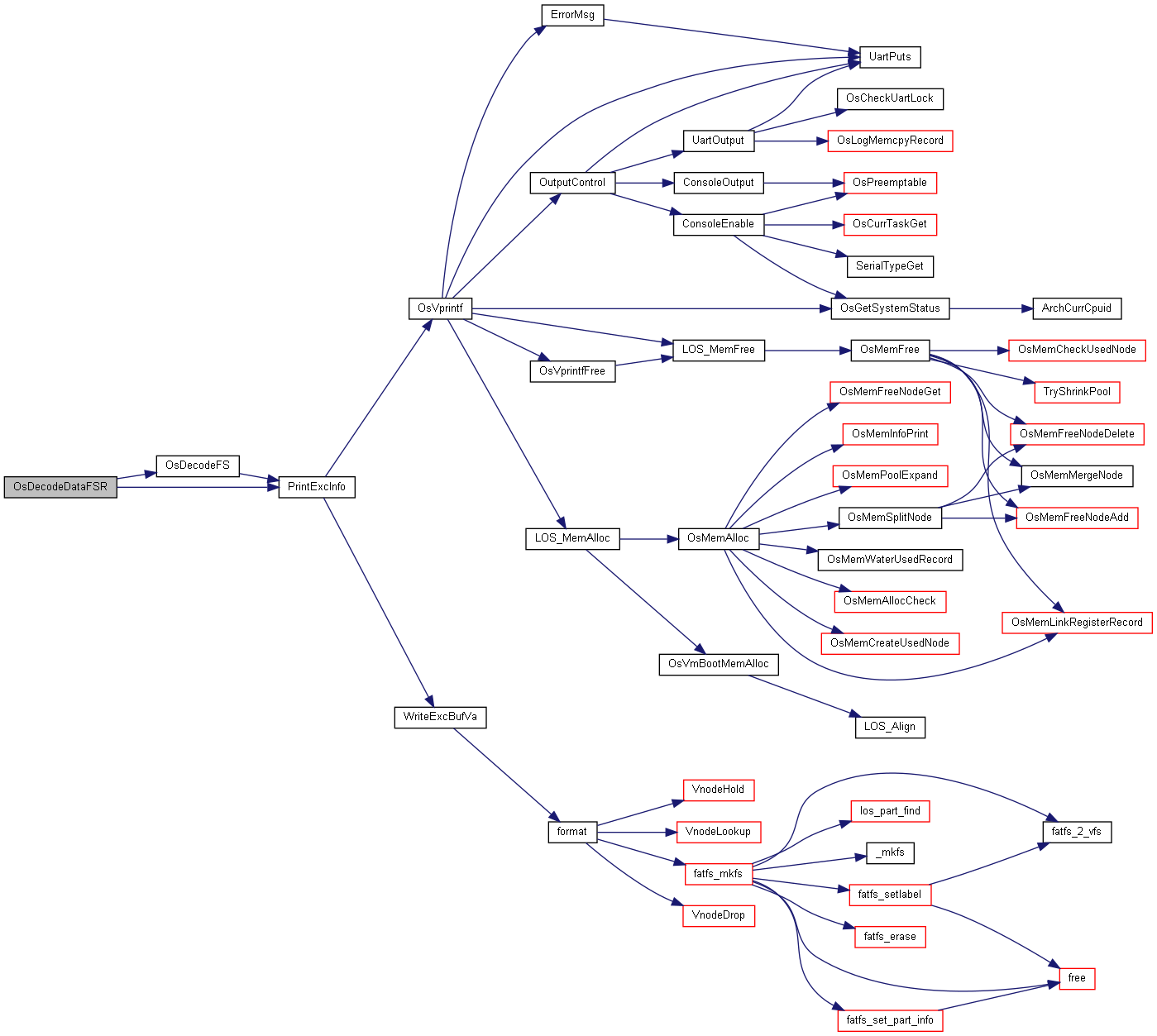
这是这个函数的调用关系图:

◆ OsDecodeFS()
函数调用图:

这是这个函数的调用关系图:

◆ OsDecodeInstructionFSR()
函数调用图:
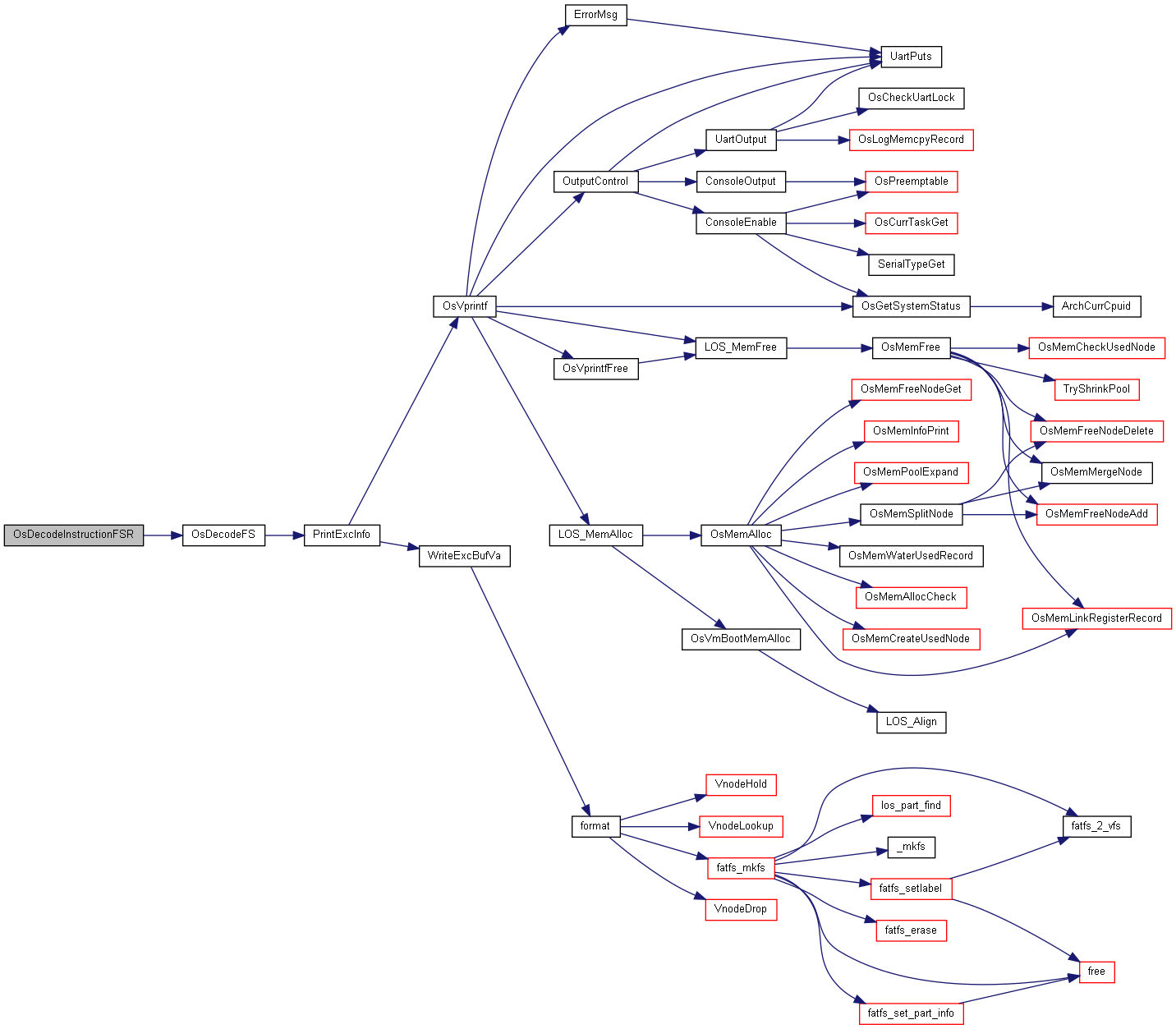
这是这个函数的调用关系图:

◆ OsDumpContextMem()
| VOID OsDumpContextMem | ( | const ExcContext * | excBufAddr | ) |
dump 上下文内存,注意内核异常不能简单的映射理解为应用的异常,异常对内核来说是一个很常见操作,
比如任务的切换对内核来说就是一个异常处理
打印异常上下文
- 参数
-
excBufAddr
- 返回
- VOID
函数调用图:

这是这个函数的调用关系图:

◆ OsDumpExcVaddrRegion()
| STATIC VOID OsDumpExcVaddrRegion | ( | LosVmSpace * | space, |
| LosVmMapRegion * | region | ||
| ) |
dump 虚拟空间下异常虚拟地址线性区
函数调用图:

这是这个函数的调用关系图:

◆ OsDumpProcessUsedMemNode()
| STATIC VOID OsDumpProcessUsedMemNode | ( | UINT16 | vmmFlags | ) |
dump 进程使用的内存节点
STATIC VOID OsDumpProcessUsedMemRegion(LosProcessCB *runProcess, LosVmSpace *runspace, UINT16 vmmFlags)
dump 进程使用的内存线性区
Definition: los_exc.c:557
STATIC INLINE BOOL OsProcessIsUserMode(const LosProcessCB *processCB)
Definition: los_process_pri.h:299
函数调用图:

这是这个函数的调用关系图:

◆ OsDumpProcessUsedMemRegion()
| STATIC VOID OsDumpProcessUsedMemRegion | ( | LosProcessCB * | runProcess, |
| LosVmSpace * | runspace, | ||
| UINT16 | vmmFlags | ||
| ) |
dump 进程使用的内存线性区
567 PrintExcInfo("%3u -> regionBase: 0x%08x regionSize: 0x%08x\n", count, region->range.base, region->range.size);
STATIC VOID OsDumpExcVaddrRegion(LosVmSpace *space, LosVmMapRegion *region)
dump 虚拟空间下异常虚拟地址线性区
Definition: los_exc.c:515
INT32 OsRegionOverlapCheckUnlock(LosVmSpace *space, LosVmMapRegion *region)
Definition: los_vm_dump.c:85
Definition: los_rbtree.h:51
Definition: los_vm_map.h:119
函数调用图:

这是这个函数的调用关系图:

◆ OsExcHandleEntry()
| LITE_OS_SEC_TEXT_INIT VOID OsExcHandleEntry | ( | UINT32 | excType, |
| ExcContext * | excBufAddr, | ||
| UINT32 | far, | ||
| UINT32 | fsr | ||
| ) |
VOID(* log_read_write_fn)(UINT32 startAddr, UINT32 space, UINT32 rwFlag, CHAR *buf)
define the type of functions for reading or writing exception information.
Definition: los_config.h:435
LITE_OS_SEC_TEXT_MINOR VOID LOS_Mdelay(UINT32 msecs)
以ms为单位的忙等,但可以被优先级更高的任务抢占
Definition: los_hw_tick.c:73
int BBoxNotifyError(const char event[EVENT_MAX_LEN], const char module[MODULE_MAX_LEN], const char errorDesc[ERROR_DESC_MAX_LEN], int needSysReset)
Definition: los_blackbox_core.c:397
STATIC VOID OsSysStateRestore(UINT32 intCount, UINT32 lockCount)
Definition: los_exc.c:1257
LITE_OS_SEC_TEXT VOID STATIC OsExcPriorDisposal(ExcContext *excBufAddr)
执行期间的优先处理 excBufAddr为CPU异常上下文,
Definition: los_exc.c:1201
STATIC VOID OsSysStateSave(UINT32 *intCount, UINT32 *lockCount)
Definition: los_exc.c:1249
函数调用图:

◆ OsExcHook()
| VOID OsExcHook | ( | UINT32 | excType, |
| ExcContext * | excBufAddr, | ||
| UINT32 | far, | ||
| UINT32 | fsr | ||
| ) |
由注册后回调,发送异常情况下会回调这里执行,见于 OsUndefIncExcHandleEntry, OsExcHandleEntry ==函数
943{ //参考文档 https://gitee.com/openharmony/docs/blob/master/kernel/%E7%94%A8%E6%88%B7%E6%80%81%E5%BC%82%E5%B8%B8%E4%BF%A1%E6%81%AF%E8%AF%B4%E6%98%8E.md
950 (VOID) OsShellCmdTskInfoGet(OS_ALL_TASK_MASK, NULL, OS_PROCESS_INFO_ALL); //打印进程线程基本信息 相当于执行下 shell task -a 命令
VOID OsDumpContextMem(const ExcContext *excBufAddr)
dump 上下文内存,注意内核异常不能简单的映射理解为应用的异常,异常对内核来说是一个很常见操作, 比如任务的切换对内核来说就是一个异常处理
Definition: los_exc.c:608
STATIC VOID OsExcType(UINT32 excType, ExcContext *excBufAddr, UINT32 far, UINT32 fsr)
异常类型
Definition: los_exc.c:326
STATIC VOID OsExcSysInfo(UINT32 excType, const ExcContext *excBufAddr)
打印异常系统信息
Definition: los_exc.c:401
UINT32 OsShellCmdMemCheck(INT32 argc, const CHAR *argv[])
Definition: mempt_shellcmd.c:95
UINT32 OsShellCmdTskInfoGet(UINT32 taskID, VOID *seqfile, UINT16 flag)
Definition: task_shellcmd.c:585
函数调用图:

◆ OsExcInit()
| VOID OsExcInit | ( | VOID | ) |
异常接管模块的初始化
VOID OsExcStackInfoReg(const StackInfo *stackInfo, UINT32 stackNum)
注册栈信息
Definition: los_stackinfo.c:138
函数调用图:

这是这个函数的调用关系图:

◆ OsExcPriorDisposal()
| LITE_OS_SEC_TEXT VOID STATIC OsExcPriorDisposal | ( | ExcContext * | excBufAddr | ) |
执行期间的优先处理 excBufAddr为CPU异常上下文,
函数调用图:
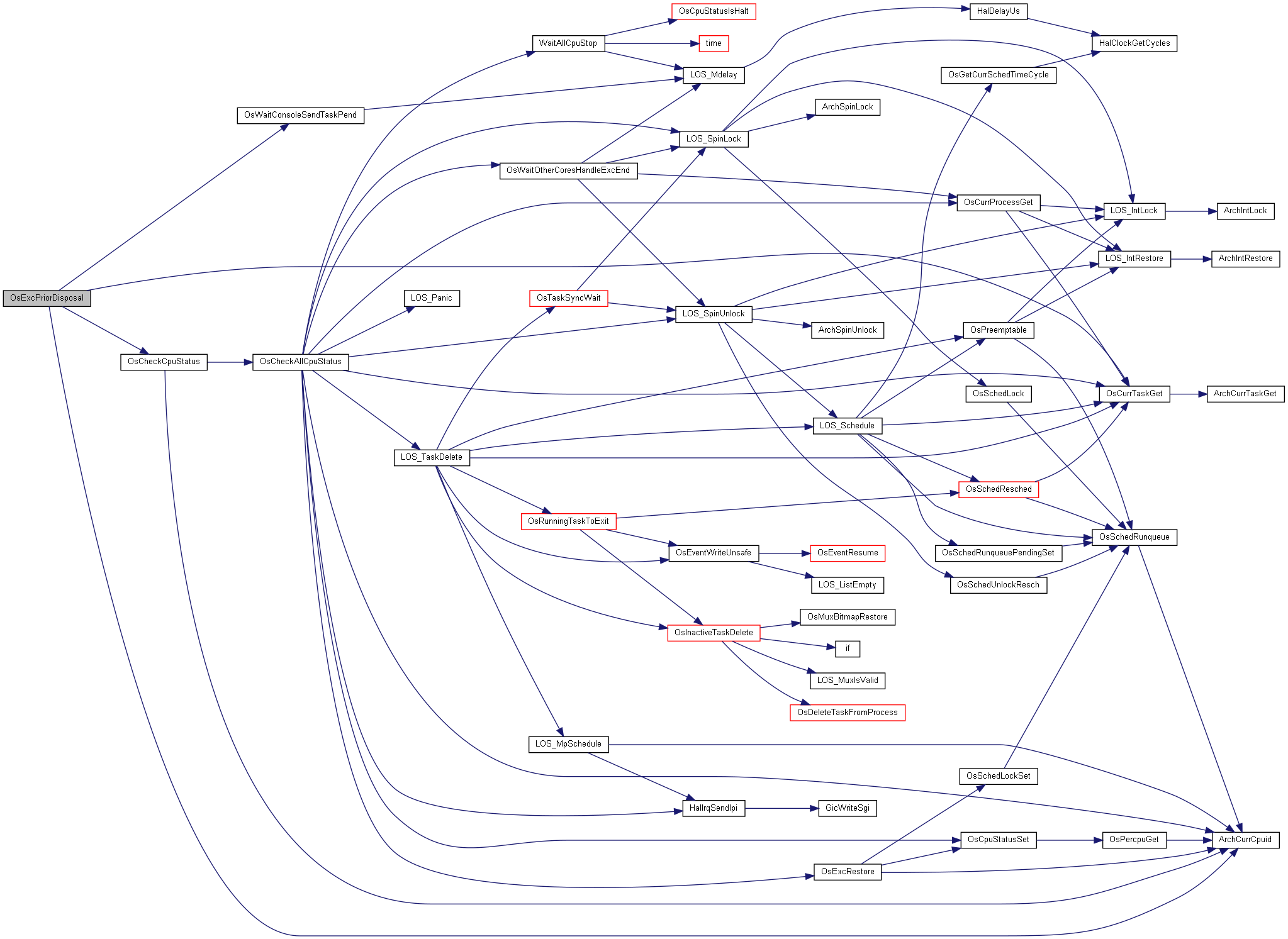
这是这个函数的调用关系图:

◆ OsExcRegHookGet()
| EXC_PROC_FUNC OsExcRegHookGet | ( | VOID | ) |
◆ OsExcRegsInfo()
| STATIC VOID OsExcRegsInfo | ( | const ExcContext * | excBufAddr | ) |
异常情况下打印各寄存器的信息
- 参数
-
excBufAddr
- 返回
- STATIC
函数调用图:

这是这个函数的调用关系图:

◆ OsExcRestore()
| STATIC VOID OsExcRestore | ( | VOID | ) |
异常恢复,继续执行
函数调用图:

这是这个函数的调用关系图:

◆ OsExcSysInfo()
| STATIC VOID OsExcSysInfo | ( | UINT32 | excType, |
| const ExcContext * | excBufAddr | ||
| ) |
打印异常系统信息
- 参数
-
excType excBufAddr
- 返回
- STATIC
STATIC VADDR_T OsGetTextRegionBase(LosVmMapRegion *region, LosProcessCB *runProcess)
Definition: los_exc.c:359
const CHAR * OsGetRegionNameOrFilePath(LosVmMapRegion *region)
Definition: los_vm_dump.c:57
LosVmMapRegion * LOS_RegionFind(LosVmSpace *vmSpace, VADDR_T addr)
查找线性区 根据起始地址在进程空间内查找是否存在
Definition: los_vm_map.c:414
函数调用图:
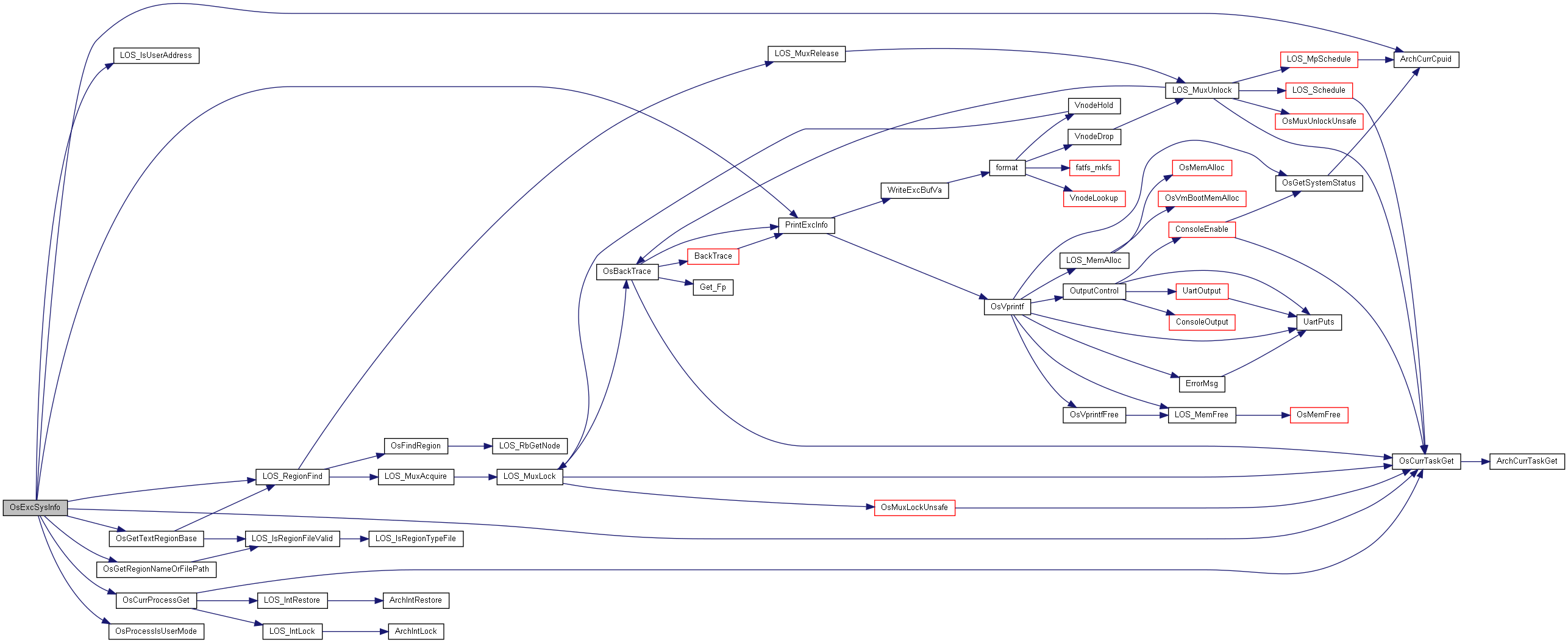
这是这个函数的调用关系图:

◆ OsExcType()
| STATIC VOID OsExcType | ( | UINT32 | excType, |
| ExcContext * | excBufAddr, | ||
| UINT32 | far, | ||
| UINT32 | fsr | ||
| ) |
异常类型
函数调用图:

这是这个函数的调用关系图:

◆ OsGetSystemStatus()
| UINT32 OsGetSystemStatus | ( | VOID | ) |
获取系统状态
函数调用图:

这是这个函数的调用关系图:
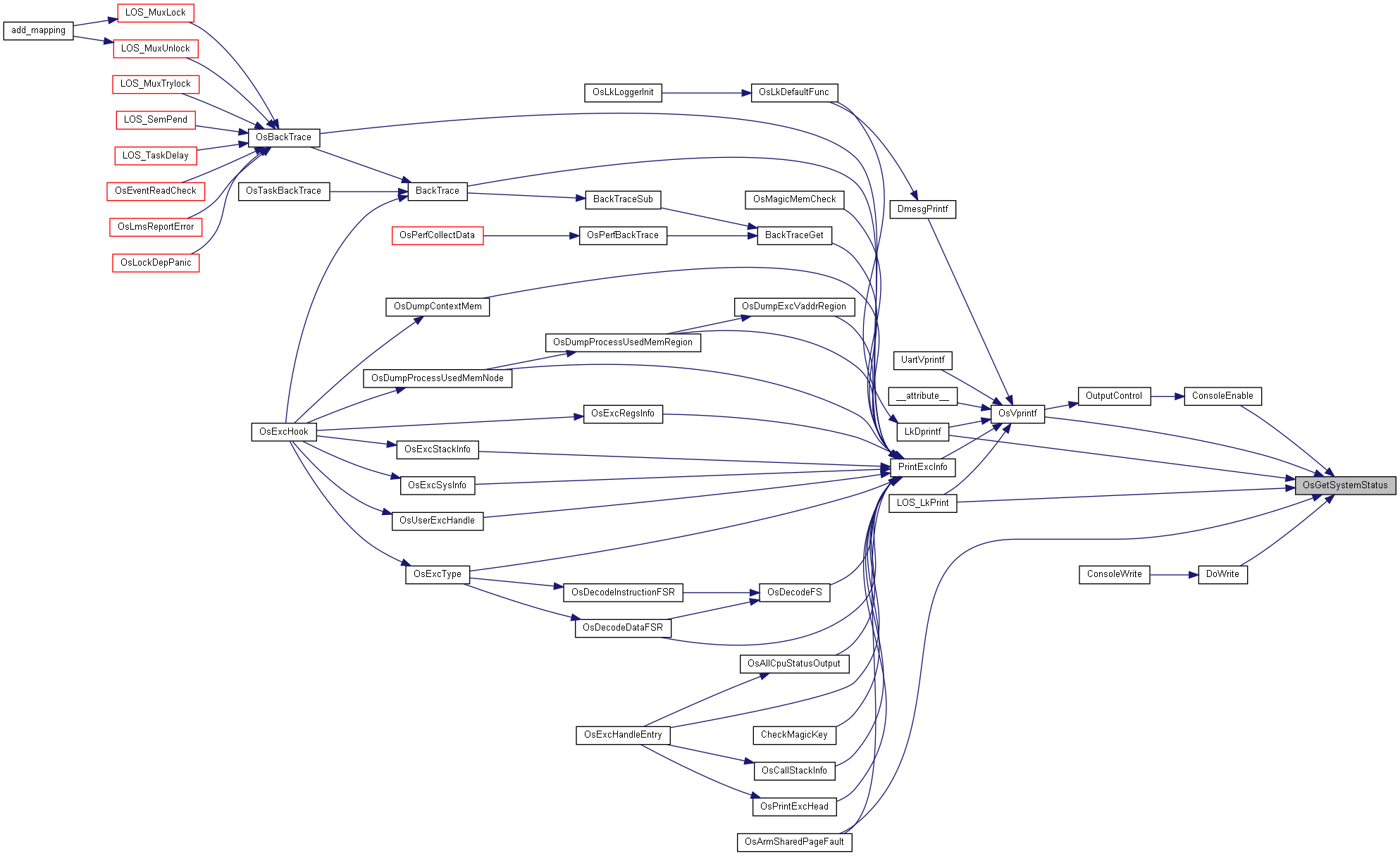
◆ OsGetTextRegionBase()
| STATIC VADDR_T OsGetTextRegionBase | ( | LosVmMapRegion * | region, |
| LosProcessCB * | runProcess | ||
| ) |
struct VmMapRegion::@4::VmRegionFile rf
union VmMapRegion::@4 unTypeData
函数调用图:
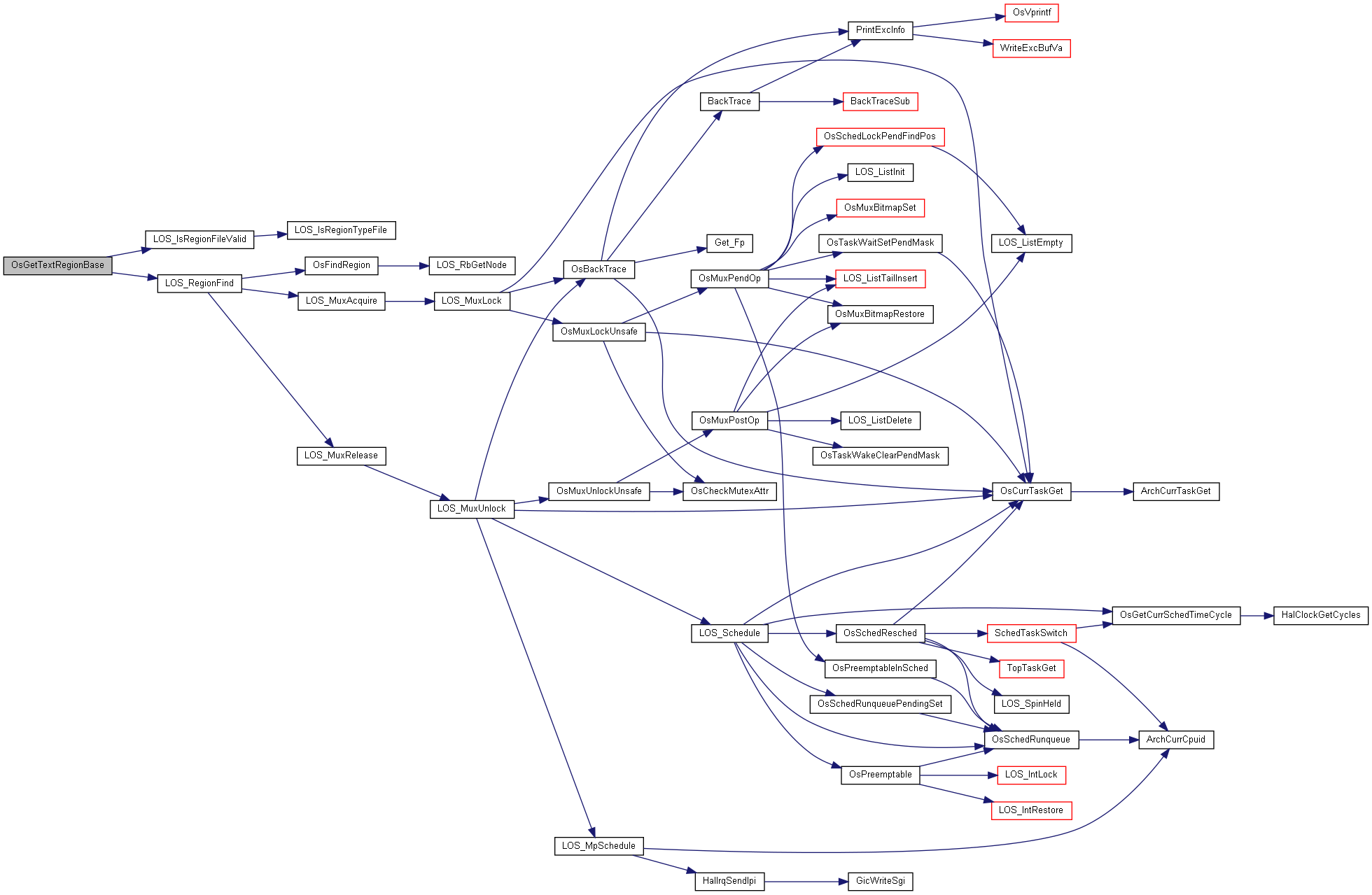
这是这个函数的调用关系图:
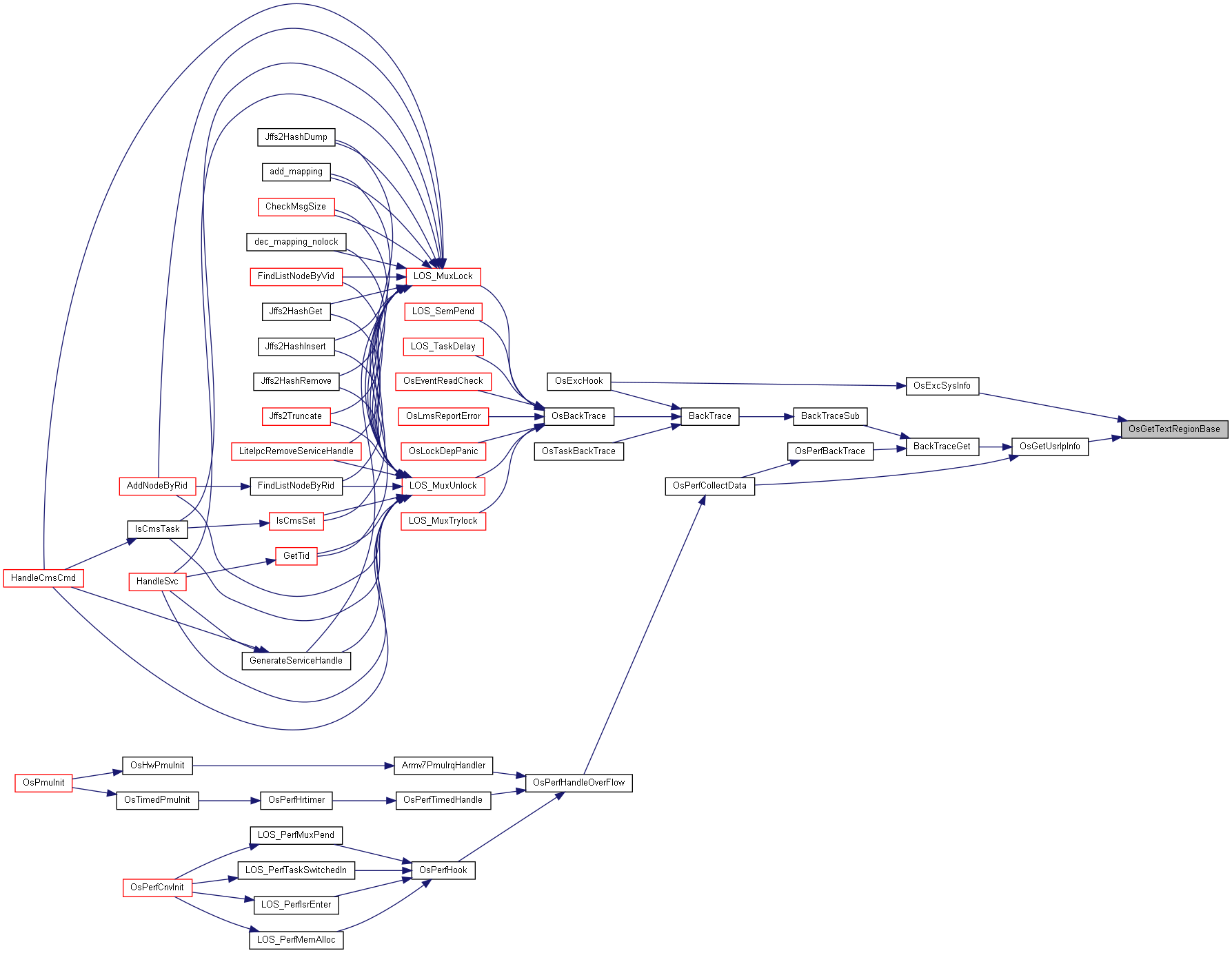
◆ OsGetUsrIpInfo()
函数调用图:
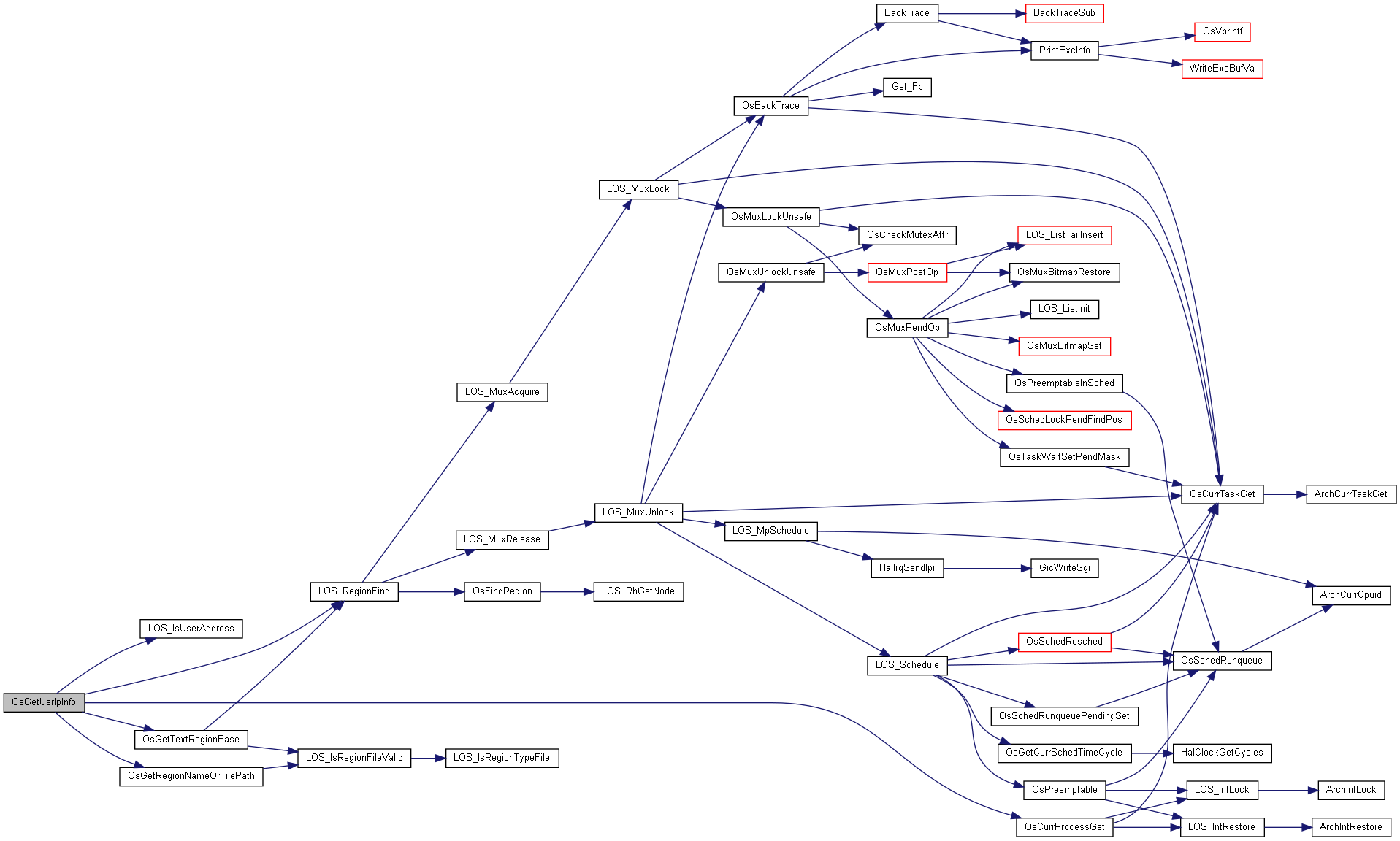
这是这个函数的调用关系图:
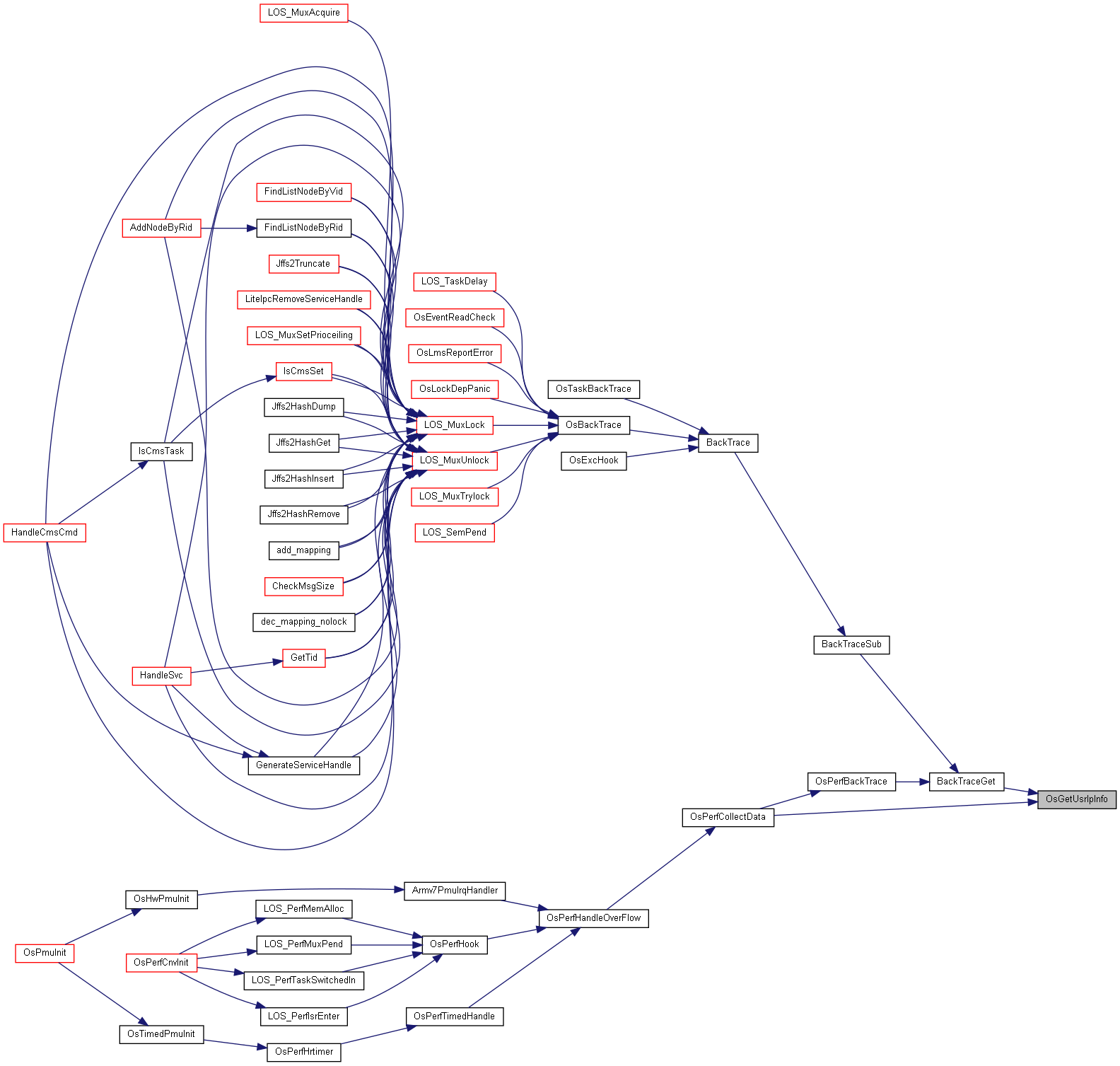
◆ OsPrefetchAbortExcHandleEntry()
| VOID OsPrefetchAbortExcHandleEntry | ( | ExcContext * | excBufAddr | ) |
预取指令异常处理函数,由汇编调用 见于 los_hw_exc.s
1065 far = OsArmReadIfar(); //far 为CP15的 C6寄存器 详见:https://blog.csdn.net/kuangyufei/article/details/108994081
函数调用图:

◆ OsPrintExcHead()
| LITE_OS_SEC_TEXT_INIT STATIC VOID OsPrintExcHead | ( | UINT32 | far | ) |
异常信息头部打印
函数调用图:

这是这个函数的调用关系图:

◆ OsSysStateRestore()
函数调用图:

这是这个函数的调用关系图:

◆ OsSysStateSave()
函数调用图:

这是这个函数的调用关系图:

◆ OsUndefIncExcHandleEntry()
| VOID OsUndefIncExcHandleEntry | ( | ExcContext * | excBufAddr | ) |
未定义的异常处理函数,由汇编调用 见于 los_hw_exc.s
◆ OsUserExcHandle()
| STATIC VOID OsUserExcHandle | ( | ExcContext * | excBufAddr | ) |
用户态异常处理函数
691 /* An exception was raised by a task that is not the current main thread during the exit process of
708 /* User mode exception handling failed , which normally does not exist */ //用户态的异常处理失败,通常情况下不会发生
STATIC INLINE VOID OsProcessExitCodeSignalSet(LosProcessCB *processCB, UINT32 signal)
设置进程退出信号(0 ~ 7)
Definition: los_process_pri.h:323
STATIC INLINE VOID OsProcessExitCodeCoreDumpSet(LosProcessCB *processCB)
置进程退出码第七位为1
Definition: los_process_pri.h:318
LITE_OS_SEC_TEXT VOID OsRunningTaskToExit(LosTaskCB *runTask, UINT32 status)
Definition: los_task.c:908
函数调用图:
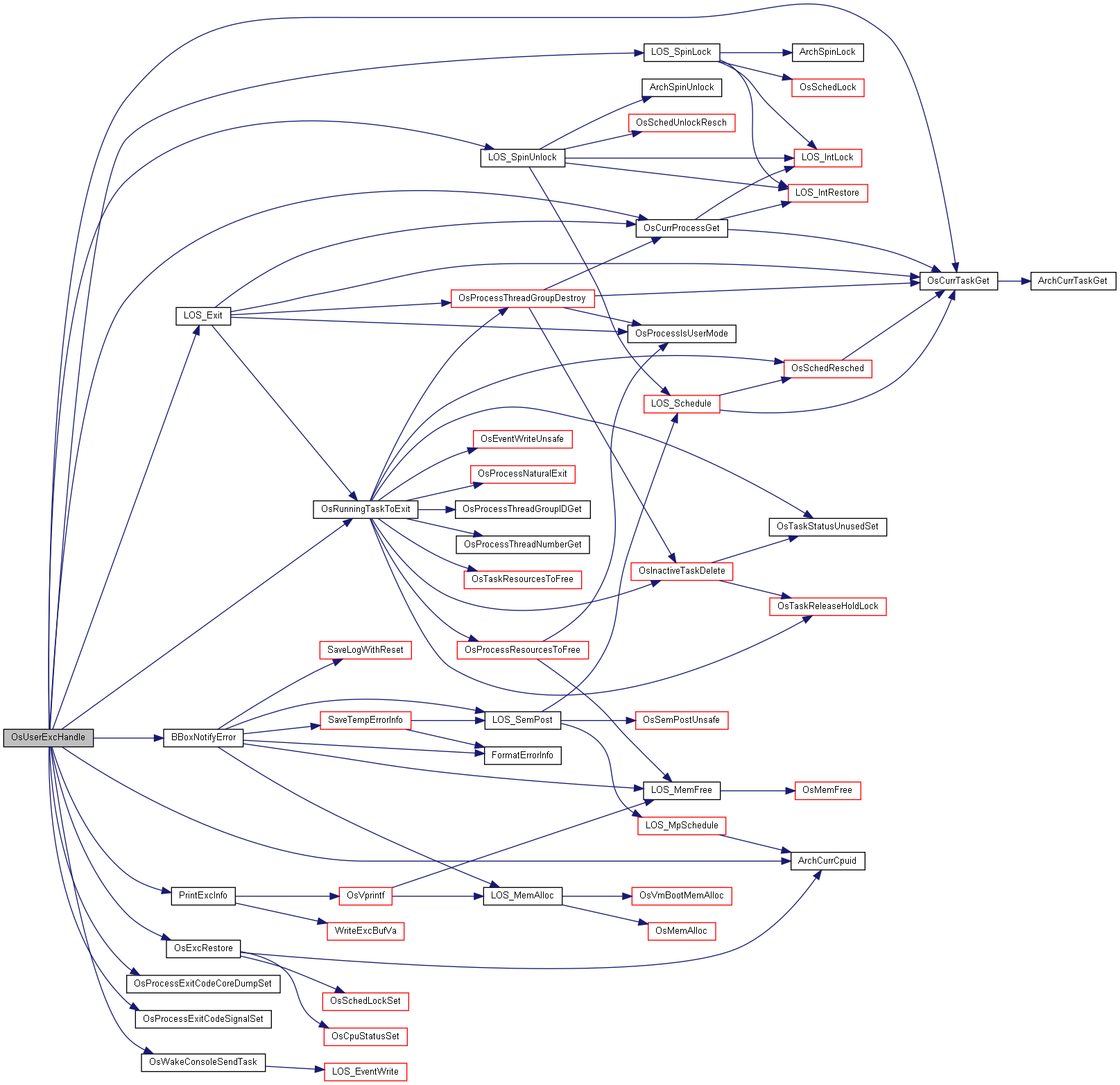
这是这个函数的调用关系图:

◆ OsWaitOtherCoresHandleExcEnd()
| STATIC VOID OsWaitOtherCoresHandleExcEnd | ( | UINT32 | currCpuid | ) |
函数调用图:

这是这个函数的调用关系图:

◆ SPIN_LOCK_INIT()
| STATIC SPIN_LOCK_INIT | ( | g_excSerializerSpin | ) |
◆ WaitAllCpuStop()
| STATIC VOID WaitAllCpuStop | ( | UINT32 | cpuid | ) |
等待所有CPU停止
STATIC INLINE UINT32 OsCpuStatusIsHalt(UINT16 cpuid)
Definition: los_percpu_pri.h:71
函数调用图:

这是这个函数的调用关系图:

变量说明
◆ __stack_chk_guard
◆ g_curNestCount
◆ g_currHandleExcCpuid
◆ g_currHandleExcPID
◆ g_excFromUserMode
| BOOL g_excFromUserMode[LOSCFG_KERNEL_CORE_NUM] |
◆ g_excHook
| STATIC EXC_PROC_FUNC g_excHook = (EXC_PROC_FUNC)OsExcHook |
◆ g_excStack
| STATIC const StackInfo g_excStack[] |
初始值:
= {
{&__svc_stack, OS_EXC_SVC_STACK_SIZE, "svc_stack"},
{&__exc_stack, OS_EXC_STACK_SIZE, "exc_stack"}
}
UINTPTR __exc_stack
UINTPTR __svc_stack
6种异常情况下对应的栈,每一种异常模式都有其独立的堆栈,用不同的堆栈指针来索引,
这样当ARM进入异常模式的时候,程序就可以把一般通用寄存器压入堆栈,返回时再出栈,
保证了各种模式下程序的状态的完整性
用户模式,运行应用程序的普通模式。限制你的内存访问并且不能直接读取硬件设备。
超级用户模式(SVC 模式),主要用于 SWI(软件中断)和 OS(操作系统)。这个模式有额外的特权,
允许你进一步控制计算机。例如,你必须进入超级用户模式来读取一个插件(podule)。
这不能在用户模式下完成。
中断模式(IRQ 模式),用来处理发起中断的外设。这个模式也是有特权的。导致 IRQ 的设备有
键盘、 VSync (在发生屏幕刷新的时候)、IOC 定时器、串行口、硬盘、软盘、等等...
快速中断模式(FIQ 模式),用来处理发起快速中断的外设。这个模式是有特权的。导致 FIQ 的设备有
处理数据的软盘,串行端口。
IRQ 和 FIQ 之间的区别是对于 FIQ 你必须尽快处理你事情并离开这个模式。
IRQ 可以被 FIQ 所中断但 IRQ 不能中断 FIQ
*
◆ g_excTypeString
| STATIC const CHAR* g_excTypeString[] |